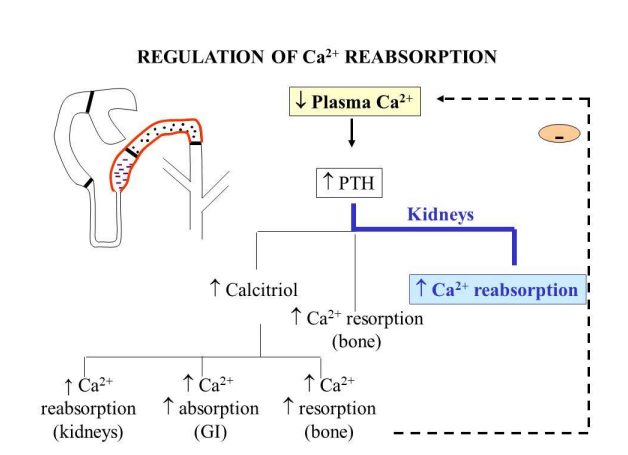POTASSIUM, CALCIUM, PHOSHPATE, MAGNESIUM AND CHLORIDE HOMEOSTASIS
1/67
There's no tags or description
Looks like no tags are added yet.
Name | Mastery | Learn | Test | Matching | Spaced |
|---|
No study sessions yet.
68 Terms
______ effects the electrical systems of the body.
a) Sodium
b) Potassium
b)
______ effects water movement and thus effects extracellular volume.
a) Sodium
b) Potassium
a)
PK+ is large: most cells, both excitable and non-excitable, are mostly permeable to potassium at rest. Thus the membrane potential is influenced by changes in external potassium concentration, but not so much by changes in the external sodium concentration.
a) True
b) False
a)
Sodium does not exert a strong electrical influence. However sodium does alter water movement. Because water moves freely throughout the body, small changes in the external sodium concentration can result in significant changes in plasma volume.
a) True
b) False
a)
Hypokalemia
Increased K+ loss
Non renal losses: vomit, diarrhea, sweat loss
Renal losses: hyperaldosteronism, diuretics, ↑ flow rate
K+ Redistribution: ↑ insulin, α-adrenergic antagonist, ↑ aldosterone, alkalosis, ↓ plasma osmolarity
↓ K+ input: low K+ diet
Hyperkalemia
↓ K+ loss
↓GFR (less than 20% normal)
↓ plasma aldosterone
K+ Redistribution:
↑ insulin, β-adrenergic antagonist, cell lysis, exercise
↑ plasma osmolarity
↑ K+ input: high K+ diet
Osmolarity:
How would an increase in plasma osmolarity affect water in cells?
a) An increase in plasma osmolarity would cause cells to absorb more water
b) An increase in plasma osmolarity would cause water to be drawn out out of cells
b)
Osmolarity:
How does the increase in plasma osmolarity and water sucked out from cells affect K+
a) It causes an increase in intracellular K+ concentration which favors exit of K+ out of the cell
b) It causes an increase in intracellular K+ concentration which favors entry of K+ into the cell
c) It causes an increase in extracellular K+ concentration which favors exit of K+ out of the cell
d) None of the above
a)
What does pH alter?
pH alters [K+] concentration
↑[H+]outside _______ activity of transporter
a) increases
b) decreases
b)
______ K+ transported inside cell ——> hyperkalemia
a) less K+ transported
b) more K+ transported
a)
_____ is often (but not always) associated with acidosis
a) Hyperkalemia
b) Hypokalemia
a)
_____ is often (but not always) associated with alkalosis
a) Hyperkalemia
b) Hypokalemia
b)
Diarrhea —→ _____ HCO3- —→ ____pH —→ ____ K+
a) ↑ HCO3- —→ ↑ pH —→ ↑ K+
b) ↑ HCO3- —→ ↓ pH —→ ↓ K+
c) ↓ HCO3- —→ ↓ pH —→ ↓ K+
d) ↓ HCO3- —→ ↑ pH —→ ↑ K+
c)
Diarrhea —> ____ K+
a) Increase K+
b) Decrease K+
b)
Vomit —→ loss of _____ and ____
a) HCO3- and K+
b) H+ and K+
b)
Diarrhea —→ loss of _____ and ____
a) HCO3- and K+
b) H+ and K+
a)
Insulin —→ ____ K+ uptake into cells
a) increase K+ uptake
b) decrease K+ uptake
a)
> 5mEq/L
a) Hypokalemia
b) Hyperkalemia
b)
< 3.5 mEq/L
a) Hypokalemia
b) Hyperkalemia
a)
Which of the following is best described below?
Heart=
Arrhythmias
Vasculature=
Vasodilation: mechanism unknown
Muscle=
Paresthesias, muscle weakness, paralysis
Kidney=
Acidosis
a) Hyperkalemia
b) Hypokalemia
a)
Which of the following is best described below?
Heart=
Arrhythmias
Vasculature=
Vasodilation: ↓ [K+] —> muscle relaxation, edema (↑ NaCl reabsorption)
Muscle=
Muscle weakness, fatigue, cramps
Kidney=
Alkalosis, ↓ GFR
Pancreas=
↓ Insulin release —> glucose intolerance*
GI=
Constipation, ileus
a) Hyperkalemia
b) Hypokalemia
b)
Which of the following is best described:
Total amount of K+ in all body compartments (ECF and ICF) and plasma [K+]
Total body K+
Which of the following is best described:
A patient can have low total body K+ but normal plasma K+. Why is this?
This is because if the body is being depleted of potassium, potassium will shift from the ICF to the ECF. As a result of this redistribution of potassium from the ICF to the ECF, plasma K+ will be normal, but total body K+ will be low.
After ingestion, potassium can either be:
Excreted from the body
Taken up by cells
Excretion of potassium is via the kidneys and is regulated by ______ and _____
regulated by aldosterone and the plasma concentration of potassium

In the image, which is removed by the kidneys slowly?
plasma K+ and aldosterone
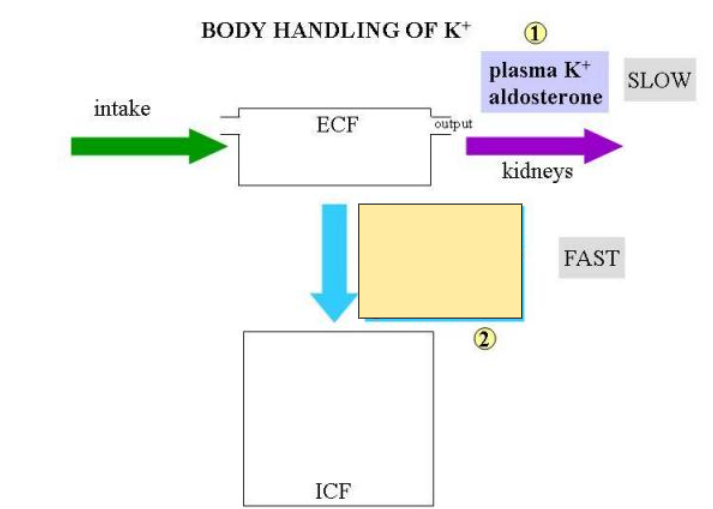
In the image, what regulates transport of K+ from the extracellular space to the intracellular space? (occurs quickly)
Insulin
Catecholamines
Aldosterone
plasma K+
Insulin, Catecholamines, and aldosterone _______ Na+/ K+ ATPase which causes ______ K+ movement into cells
a) stimulate, increase in K+ movement into cells
b) inhibit, decrease in K+ movement into cells
a)
Which of the following is best described:
Na+/K+ ATPase pump:
_____ acts on B2 and alpha receptors
Stimulation of alpha receptors inhibits K+ uptake
a) Aldosterone
b) Catecholamines
c) Insulin
b)
Which of the following is best described:
Na+/K+ ATPase pump:
_____ binds to an intracellular receptor
a) Aldosterone
b) Catecholamines
c) Insulin
a)
When insulin is given to diabetic patients, ____ is often added as a supplement to prevent _____
a) K+ added, prevent hyperkalemia
b) K+ added, prevent hypokalemia
b)
Large fraction of K+ is reabsorbed by _______
proximal tubule
Smaller fraction of K+ reabsorbed by _______
Thick ascending limb
Early distal tubule
Medullary collecting ducts
Low K+ intake —→ K+ is _____ in distal tubule and collecting ducts
a) K+ secreted
b) K+ reabsorbed
b)
With a normal or high K+ intake, K+ is _____ in the distal tubule and collecting ducts
a) K+ secreted
b) K+ reabsorbed
a)
In the proximal tubule, K+ reabsorption is ______
a) active via the transcellular pathway
b) passive via the paracellular pathway
b)
In the thick ascending limb, K+ reabsorption is _______
a) active via the transcellular pathway
b) passive via the paracellular pathway
a)
In order to maintain potassium homeostasis, K + secretion by the distal tubule and the cortical collecting duct is regulated mainly by:
Aldosterone
Plasma potassium concentration
Distal tubule and collecting ducts contain what basic types of cells?
principal cells
intercalated cells
Which basic cell type found in the Distal tubule and Collecting ducts is best described?
K+ secreting cells
a) intercalated cells
b) principal cells
b)
Which basic cell type found in the Distal tubule and Collecting ducts is best described?
interspersed between the principal cells and come in two types: A (secrete H+ ) and B (secrete HCO3 - ).
a) intercalated cells
b) principal cells
a)
Potassium is secreted by _____ cells in the late distal tubule and collecting ducts
a) intercalated cells
b) principal cells
b)
Inner medullary collecting duct cells do not contain intercalated cells
a) true
b) false
a)
Potassium is secreted by the principal cells in the late distal tubule and collecting ducts:
the Na+ -K + - ATPase transports potassium against its concentration gradient from the interstitial space to the inside of a principal cell.
potassium channels in the apical membrane transport potassium down its concentration gradient from the inside of the principal cell to the nephron lumen
a) 2, 1
b) 1, 2
b)
Regulation of potassium secretion occurs by altering:
Number and rate of the Na+ -K + -ATPase
Number of open potassium channels in the apical membrane.
The gradient of the potassium concentration from the inside of the blood vessel to the nephron lumen:
[K+ ]blood -[K+ ]lumen.
Potassium secretion is coupled to Na+ reabsorption
a) true
b) false
a)
An increase in plasma [K+] —> ____ Aldosterone secretion from adrenal cortex —→ ______ activity of Na+/K+ ATPase and _____ luminal K+ permeability —> Increase in K+ secretion
a) ↑ Aldosterone secretion from adrenal cortex —→ ↓ activity of Na+/K+ ATPase and ↓ luminal K+ permeability
b) ↓ Aldosterone secretion from adrenal cortex —→ ↓ activity of Na+/K+ ATPase and ↓ luminal K+ permeability
c) ↑ Aldosterone secretion from adrenal cortex —→ ↑ activity of Na+/K+ ATPase and ↑ luminal K+ permeability
d) ↑ Aldosterone secretion from adrenal cortex —→ ↓ activity of Na+/K+ ATPase and ↓ luminal K+ permeability
c)
An increase in plasma [K+] —> ____ rate and # of Na+/K+ ATPases in the basolateral membrane —→ _____ potassium permeability of the apical or luminal membrane —→ Increase in K+ secretion
a) ↑ rate and # of Na+/K+ ATPases in the basolateral membrane —→ ↑ potassium permeability of the apical or luminal membrane
b) ↓ rate and # of Na+/K+ ATPases in the basolateral membrane —→ ↑ potassium permeability of the apical or luminal membrane
c) ↓ rate and # of Na+/K+ ATPases in the basolateral membrane —→ ↓ potassium permeability of the apical or luminal membrane
a)
An increase in plasma [K+] —> ____ in the concentration gradient from blood to lumen —→ Increase in K+ secretion
a) increase in concentration gradient
b) decrease in concentration gradient
a)
Aldosterone escape
Long term excess of aldosterone
Chronic high aldosterone increases Na+ reabsorption and K+ secretion
Increase in water retention
Increase in blood volume
Compensatory decrease in Na+ reabsorption
Decrease in Na+ excretion and return plasma Na+ back to normal values
Factors that Influence K+ secretion
Luminal anions
High Na+ delivery to DT
Increased flow to DT
An increase in tubular flow rate will increases K+ secretion by at least two mechanisms:
washes away secreted K+ so that [K+ ]lumen decreases. This increases [K+ ]blood - [K+ ]lumen so K+ secretion increases.
Increases Na+ delivery to the distal tubule. Increased Na+ to the distal tubule will stimulate Na+ reabsorption and K+ secretion in the distal tubule and collecting ducts.
Acid base effects on K+ secretion:
↓ plasma pH Chronic —→ Proximal tubule pathway
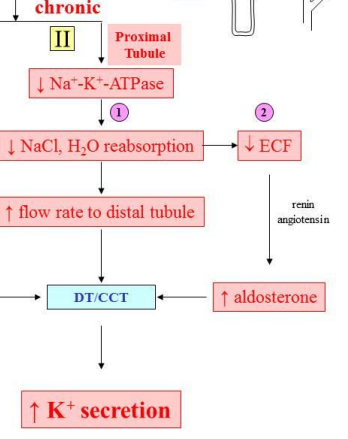
Acid base effects on K+ secretion:
↓plasma pH Chronic —→ Skeletal muscle pathway
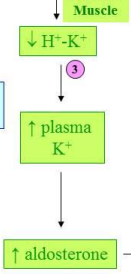
Acid base effects on K+ secretion:
↓plasma pH acute—→ ____ pathway
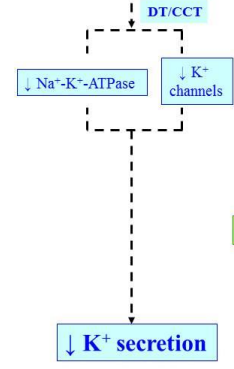
Calcium, phosphate and magnesium are not always free in plasma, but are often bound to proteins, mostly albumin, or complexed to anions (HCO3 - , citrate, Pi, SO4 2- ).
a) True
b) False
a)
Only the amount of Calcium, phosphate and magnesium ____ or ____ to anions is filtered by the kidneys, and therefore only this form can be regulated by the kidneys.
ionized or complexed to anions
which of the following is best described:
↑ excitability
a) Hypocalcemia
b) Hypercalcemia
a)
which of the following is best described:
↓ excitability, cardiac arrhythmias, lethargy, disorientation
a) Hypocalcemia
b) Hypercalcemia
b)
which of the following is best described:
calcium deposition in bone
a) Formation
b) Resorption
a)
which of the following is best described:
calcium loss from bone
a) Formation
b) Resorption
b)
Calcium is mostly reabsorbed in the _____
proximal tubule
Calcium 1% excretion is = _____
amount ingested
Calcium reabsorbed in Proximal tubule/ Thick ascending limb:
a) 80% paracellular and 20% transcellular
b) 100% transcellular
a)
Calcium reabsorbed in Distal tubule
a) 80% paracellular and 20% transcellular
b) 100% transcellular
b)
A decrease in plasma calcium concentration triggers an increase in the secretion of parathyroid hormone
increases calcium reabsorption by the kidney
increases bone resorption
increases plasma calcitriol, which increases gastrointestinal absorption, bone resorption, and Ca2+ reabsorption by the kidneys.
